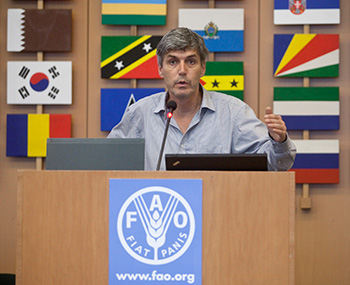Aggregation and Scaling
Regional Topic Leaders:
 Frank Ewert, Institute of Crop Science and Resource Conservation, Germany Medha Devare, International Food Policy Research Institute, USA
Frank Ewert, Institute of Crop Science and Resource Conservation, Germany Medha Devare, International Food Policy Research Institute, USA
Objective:
AgMIP research initiatives must overcome significant obstacles in scale dependence to link field-level crop models to regional and global economic models. AgMIP is developing and evaluating procedures to scale field-level outputs up to regional and country scales. Aggregation is facilitated by the availability of quality geographic data regarding the spatial distribution of climate (daily weather), topography, soils, land-use, farm-level management, socioeconomic conditions, and reported yields. While excellent data exist in some regions, data-sparse regions are often those with large spatial heterogeneity in farming conditions and practices. For these regions, AgMIP will investigate the potential of satellite, remote sensing, and other observational products to fill gaps in data. Techniques used in agricultural models that operate on scales closer to global climate model resolutions and have regional and global foci (such as GLAM, Challinor et al., 2004; LPJmL, Bondeau et al., 2007; PEGASUS, Deryng et al., 2011; IMPACT, Nelson et al., 2009; GLOBIOM, Havlík et al., 2011) will also be compared.
Aggregation of field-scale crop model outputs to a regional or larger-scale economic model generally follows one of several approaches (e.g., Hansen and Jones, 2000; Ewert et al., 2011). One approach involves disaggregating the region into approximately homogeneous sub-regions in a type of biophysical typology (Hazeu et al., 2010) with associated sentinel sites for calibrated crop model simulations, and then converting yields to regional production using planted areas in each sub-region (Burke et al., 1991; de Jager et al., 1998; Yu et al., 2010; Ruane et al., 2011). Another approach uses multivariate sensitivity tests to cast probabilistic distributions of farm-level conditions into an estimate of regional production (Haskett et al., 1995). In a third approach, farm behavior is explicitly taken into account, and crop models are linked to farm economic models to provide farm production estimates, which can subsequently be upscaled through response functions (Pérez Domínguez et al., 2009; Ewert et al., 2009). A fourth approach is to make crop model simulations at high spatial resolution but with relatively coarse management differences, potentially utilizing reported regional yields to assist in bias-correction. Relative responses to different climate futures are then aggregated up to economic units of analysis and used to adjust exogenously-determined changes in productivity (Nelson et al., 2010).
References
Bondeau, A., Smith, P., Zaehle, S., Schaphoff, S., Lucht, W., Cramer, W., Gerten, D., Lotze-Campen, H., Müller, C., Reichstein, M., Smith, B. 2007. Modelling the role of agriculture for the 20th century global terrestrial carbon balance. Global Change Biology, 13, 679–706. Burke, I.C., Kittel, T.G.F., Lauenroth, W.K., Shook, P., Yonker, C.M., Parton, W.J., 1991. Regional analysis of the Central Great Plains. BioScience. 41, 685-692. de Jager, J.M., Potgieter, A.B., van den Berg, W.J., 1998. Framework for forecasting the extent and severity of drought in maize in the Free State Province of South Africa. Agricultural Systems. 57, 351-365 Deryng, D., W. J. Sacks, C. C. Barford, and N. Ramankutty, 2011: Simulating the effects of climate and agricultural management practices on global crop yield, Global Biogeochem. Cycles, 25, GB2006. Ewert, F., van Ittersum, M.K., Bezlepkina, I., Therond, O., Andersen, E., Belhouchette, H., Bockstaller, C., Brouwer, F., Heckelei, T., Janssen, S., Knapen, R., Kuiper, M., Louhichi, K., Alkan Olsson, J., Turpin, N., Wery, J., Wien, J.E., Wolf, J., 2009. A methodology for enhanced flexibility of integrated assessment in agriculture. Environmental Science & Policy. 12, 546-561. Ewert, F., van Ittersum, M.K., Heckelei, T., Therond, O., Bezlepkina, I., Andersen, E., 2011. Scale changes and model linking methods for integrated assessment of agri-environmental systems. Agriculture, Ecosystems & Environment. 142, 6-17. Hansen, J.W., Jones, J.W., 2000. Scaling-up crop models for climate variability applications. Agricultural Systems. 65, 43-72. Haskett, J.D., Pachepsky, Y.A., Acock, B., 1995. Use of the beta distribution for parameterizing variability of soil properties at the regional level for crop yield estimation. Agricultural Systems. 48, 73-86. Havlík, P., U. Schneider, E. Schmid, H. Böttcher, S. Fritz, R. Skalský, K. Aoki, S. de Cara, G. Kindermann, F. Kraxner, S. Leduc, I. McCallum, A. Mosnier, T. Sauer, and M. Obersteiner, 2011. Global Land Use Implications of First- and Second-Generation Biofuel Targets. Energy Policy, 39, 5690–5702. Hazeu, G., Elbersen, B., Andersen, E., Baruth, B., van Diepen, C.A., Metzger, M.J., 2010. A biophysical typology for a spatially-explicit agri-environmental modeling framework, in: Brouwer, F., van Ittersum, M.K. (Eds.), Environmental and Agricultural Modelling: Integrated Approaches for Policy Impact Assessment. Springer Academic Publishing, Heidelberg, pp.159-188. Nelson, G.C., Rosegrant, M.W., Koo, J., Robertson, R., Sulser, T., Zhu, T., Ringler, C., Msangi, S., Palazzo, A., Batka, M., Magalhaes, M., Valmonte-Santos, R., Ewing, M., Lee, D., 2009: Climate Change: Impact on Agriculture and Costs of Adaptation. International Food Policy Research Institute, Washington, D.C. Nelson, G.C., Rosegrant, M.W., Palazzo, A., Gray, I., Ingersoll, C., Robertson, R., Tokgoz, S., Zhu, T., Sulser, T.B., Ringler, C., Msangi, S., You, L., 2010: Food Security, Farming, and Climate Change to 2050: Scenarios, Results Policy Options. International Food Policy Research Institute, Washington, D.C. Pérez Domínguez, I., Bezlepkina, I., Heckelei, T., Romstad, E., Oude Lansink, A.G.J.M., Kanellopoulos, A., 2009. Linking farm and market models by means of response functions. Environmental Science & Policy. 12, 588-601. Ruane, A.C., Yu, W.H., Major, D.C., Alam, M., Hussain, S.G., Khan, A.S., Hassan, A., Al Hossain, B.M.T., Goldberg, R., Horton, R.M., Rosenzweig, C., 2011. Multi-factor impact analysis of potential agricultural production for climate change adaptation in Bangladesh. in review. Yu, W.H., Alam, M., Hassan, A., Khan, A.S., Ruane, A.C., Rosenzweig, C., Major, D.C., Thurlow, J., 2010: Climate Change Risks and Food Security in Bangladesh. Earthscan, Washington, DC.
